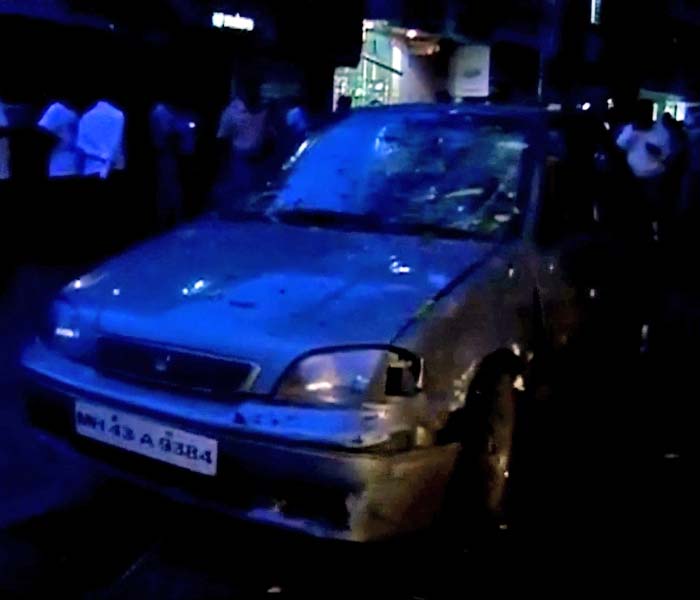India Follow-Up: 17 Dead, 131 Injured in Mumbai Bombs, No Claim of Responsibility (Times of India)
 The Times of India reports this morning:
The Times of India reports this morning:
No other city in the world has been the tragic target of as many serial terror attacks and bombings as Mumbai, which went through the agony in 1993, 2002, 2003, 2006, 2008 and now July 13, 2011. On Wednesday evening, three serial bomb blasts in the span of ten minutes ripped through three of the busiest hubs in the city — Zaveri Bazar, Opera House and Dadar — at rush hour, killing 17 people and injuring 131.
The first explosion was at 6.54pm at Zaveri Bazar, followed by another at Opera House a minute later. The third explosion was at 7.06pm outside Kabutarkhana, a few metres from the western side of Dadar railway station. This is the third terror attack at Zaveri Bazar.
The high explosives with timer devices were kept on vehicles at Opera House and Zaveri Bazar while at Dadar a bus stop was the target. The police said that the three locations, two of which were khau gallis [food lanes], had been chosen for maximum impact. Police commissioner Arup Patnaik said it was a terrorist attack.
While the Mumbai police have not named any outfit responsible for the blasts, sources say that it could be the handiwork of a banned outfit, the Indian Mujahideen (IM), which recently formed a group called the 313 Squad and has been recruiting youngsters to it.
Security agencies suspect the use of ammonium nitrate in the blasts. Splinters of nuts and bolts, which were used in the bombs, were found and removed from the injured at the Harkisondas and Saifi hospitals. The police have reportedly zeroed in on a CCTV camera near Opera House but later found that it too was damaged in the blast.
The police said that seven Improvised Explosive Devices (IEDs) were used for the blasts. "There could be at least three groups of bomb planters who kept the bomb and left quietly," said a security official, adding that the IEDs were wrapped in cloth bags and tiffin carriers—the signature of the IM. However, no terror email, another IM signature, was sent to any news channel to claim responsibility for the blasts. Soon after the blasts, the police began rounding up suspects but no arrests were made.
The bomb detection and disposal squad cordoned off the area and collected traces of explosives from the blast sites. However, due to the rain and people using water to douse the fires, the police fear that traces of explosives might have been washed away. Police sources said the anti-terrorism squad team also took the recordings of a CCTV camera installed in the vicinity of the Zaveri Bazar blast site. "The investigators can get a clear picture of how the explosion took place after watching the CCTV footage," said an officer who was at the spot. Sources said that the explosive was concealed in an umbrella which was kept on a motorcycle.
At Zaveri Bazar, local residents said the narrow lane was unusually crowded, as it was the peak hour at Khau Galli. Scores of people pack the lane, lined with food stalls, between 6 and 7 pm. Most of those injured and dead were eating at Mohan Pudlawala, a popular eatery. Businessman Hitesh Soni, who was among the first to reach the site, said, "I heard a loud thud and thought it was a cylinder blast. But when I saw people crying for help and bleeding profusely, I realized it was more than that."
The Opera House blast also happened in a Khau Galli, a favourite haunt of diamond traders and brokers. The diamond trading centre, Panchratna, is around 500 metres from the site of the blast. The police are examining if RDX was used in this blast.
Confusion reigned in hospitals as the injured and the dead were transported to seven city hospitals. When chief minister Prithviraj Chavan was accosted by relatives of the victims at GT Hospital near CST, complaining about the ill-equipped and poorly manned hospital, he refused to comment.
A group of diamond brokers was the first to react as soon as the bomb went off outside Panchratna. "We bundled bodies of bloodied men into taxis to take them to hospital without waiting to see if they were dead or alive," said a volunteer, Bhavesh, who was shaken by the brutality of the scene.
At Dadar, the police said that a device which resembled an electric meter was used as an explosive and placed near a bus stop along the Antonio D`Silva School road. Sushila Shah, a resident of Pandit Niwas opposite the blast spot, said the doors and windows of her house were flung open by the intensity of the blast. "I was cooking and I fell down with the impact. By the time I came to the window, I saw hundreds of people running helter-skelter."
The state government has convened a cabinet meeting on Thursday morning. Congress state chief Manikrao Thakre denied that it was an intelligence failure. "The police have done a lot but there is room for improvement," he said. "There is a need to beef up security, especially in crowded places."
Union home minister P Chidambaram visited the three blast sites in Mumbai late on Wednesday night to take stock of the situation.

 Thursday, July 14, 2011 at 7:18
Thursday, July 14, 2011 at 7:18
Reader Comments